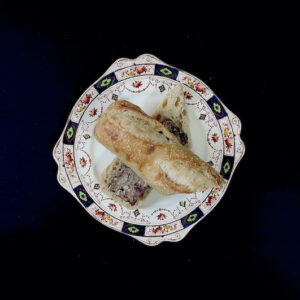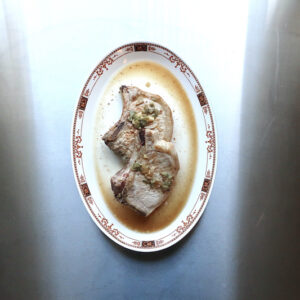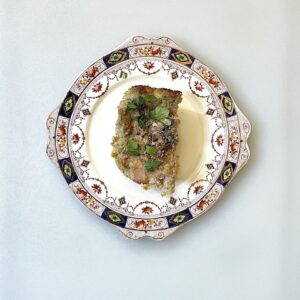Pate IK
Anthony Bourdain, ever irreverent, has this to say of paté-making:
You’ve made meat loaf, right? You’ve eaten cold meat loaf, yes? Then you’re halfway to being and ass-kicking, name-taking charcutier. ‘Oooh…paté, I don’t know.’ Please. Campagne means country in French. Which means even your country-ass can make it.”
Les Halles Cookbook
There is some truth to Bourdain’s statement, but paté and meatloaf are not the same. Meatloaf is pedestrian; it is a dish served in school cafeterias or eaten for weeknight dinners. Paté is something else again: usually built using pricier ingredients (ever heard of cognac in a meatloaf recipe?), then slowly baked in a bain marie, or water bath. Once out of the oven, a paté may be weighted and left to collect itself for a few days. During that time, it may be blanketed in lard, clarified butter, or duck fat.

Nobody coddles a meat loaf like this. They dump it on the table, smother it in catsup, and that’s that. Don’t misunderstand: I like meatloaf. But fancy it’s not.
For years I assumed paté was made strictly with pork products, only to encounter recipes by Davids Lebovitz and Tanis, in My Paris Kitchen and The New York Times, respectively. Tanis’s recipe does call for pork, but the beauty of paté is it may be tinkered with to good effect, provided you remember a few things:

Paté is served at room temperature. While generally mild in flavor, this doesn’t mean dull. Which is why paté recipes either include something piquant in the mix–cornichons, juice from the cornichon jar, a little mustard–or suggest serving those cornichons alongside the paté, or with a savory marmalade, to keep the palate awake.

Not mustard. I forgot to take a picture of it.
There is no such thing as a low-fat paté. It is not diet food. You must use some sort of fatty pork, chicken, or duck. If your meats are lean, you must add fat. Madeleine Kamman’s recipe for Paté Pas Raffine, in When French Women Cook, calls for heavy cream and a tablespoon of sour cream, along with a goodly amount of butter. This means real butter, not some substitute cooked up in a lab. Don’t even show the paté a margarine tub (you don’t have margarine in the house, do you?). I will not be held responsible for what could happen.

A few words about the cooking and storage of paté….
If you use chicken livers here, steel yourself: what emerges from the processor is truly hideous. Stay the course. The paté isn’t much prettier when cooked, but it stops resembling a murder scene. I promise.

Instead of bloody livers, this beautiful boy. I always ask before taking pictures, and this fine fellow said yes.
If you think you and yours can finish the paté within five days, great. If not, cover it with either melted clarified butter, lard, or duck fat. Then your masterpiece will keep up to ten days, refrigerated. You can also bake it in ramekins instead of one loaf pan, which means you break open only a bit at a time.

If the paté gives up a lot of jelly while cooling, spoon it off and save it in a lidded container. This flavorful byproduct may be added to bread or crackers when you eat the paté itself, or makes a delicious addition stirred into soups or stews. Unlike the paté itself, it freezes well. If you opt to leave the jelly on the paté, it will shorten the keeping time. Again, this depends on how many eaters are in your home. We’re two modest appetites, but this paté threw off virtually no jelly.

You don’t have to weight your paté, but it will slice more neatly if you do. Bricks wrapped in foil (for cleanliness), a heavy can, those weights you never use, whatever. I used canned beans and Spam, whose nice square shape was an ideal fit.

Brown food trick: put it on the prettiest plate you own.

Paté IK
Preparation time: 30 minutes
Cooking time: about 90 minutes baking time, then, ideally, 3 days seasoning before eating
Yield: one 9-inch/22cm loaf pan
Please read notes, below, for discussion of variations
1 heaping tablespoon dried currants
3 generous tablespoon Cognac, brandy, or Calvados
8 ounces/227 grams chicken livers, ideally organic
8 ounces/227 grams fatty pork: this can be ground pork, a pork chop, or a piece of loin
3-4 ounces/100 grams fatty proscuitto, pancetta, or unsmoked bacon
1-2 garlic cloves, crushed
1 lobe shallot, peeled and chunked
1 teaspoon thyme, fresh or dried
1 teaspoon salt (I used fine sea salt)
1 teaspoon pepper
1 tablespoon sharp mustard (I used Amora)
1 bay leaf (optional)
melted clarified butter, duck fat, or lard, to cover (optional)
You will need a food processor or sharp knife to make this recipe. You will also need a 9 inch/22cm loaf pan or 4-5 oven safe ramekins, along with a larger baking pan to act as a bain marie, or water bath.
Preheat your oven to 325-350F/160-180C. I find my oven does better at lower temperatures here, but use your judgement.
Place the dried fruits in a small bowl and pour the Cognac over to steep.
The next steps depend on what sort of meat you’re using. I had ground pork, so set it in a bowl while I cleaned the livers. If you have another kind of pork, slice it into pieces that will work in your processor, or, if you are cutting by hand, chop away. Either way, place the pork in a bowl large enough to hold the livers.
Place the chicken livers in a colander in the sink. Run livers under cool water. Carefully remove any green bile sacs and fatty bits–this is fat you don’t want. Pat livers dry with paper towels. Place the livers in the processor.
Return to your steeping fruits. Tip fruit and alcohol into a small pan and turn heat to medium low. You want the alcohol to just simmer a moment or two, a gentle bubble. Turn off heat, and allow fruit and alcohol to cool.
Cut the proscuitto, pancetta, or bacon into pieces your processor can manage–mine is pretty fussy. Add to processor along with garlic and shallot. Pulse 3-4 times. The result will look awful. Add the pork if it’s not ground, and pulse a few times. You want chunky mush, not baby food. Again, it will look awful but smell good. Be reassured. Tip contents back to the bowl. I like to wash processor at this point, as it’s a hated kitchen task.
Add thyme, salt, pepper, and the dried fruit alcohol mixture to bowl. Stir in the mustard. Mix everything well with a large fork, spoon, or your clean hands.
If you wish, form a small test patty and fry it in the pan you cooked the fruit in, to ensure you like the seasoning. Adjust accordingly.
At this point you can allow the mixture to rest overnight in the refrigerator, covered, and finish cooking the next day. If you go this route, turn your oven off.
If you continue cooking, pour paté mixture into the loaf pan/ramekins, placing the bay leaf in the middle. If using ramekins, either forgo the leaf or break it up, dividing it amongst the ramekins; up to you.
Place the loaf pan/ramekins in the larger baking pan. Add water to the halfway mark of loaf pan/ramekins. Don’t overfill, as you don’t want water sloshing into the food or burning you later on. Carefully place the whole thing in the oven and bake for about 90 minutes. The paté is done when it registers 160F/70C on a thermometer or looks and smells done–browned on top, and a tester comes out clean.
Remove paté from oven, minding that hot water. If you live in California, use the water for something else. Remove pan/ramekins to a heatproof surface and allow to cool, scraping any jelly off and saving it in a lidded container. If you didn’t read about jelly in the post, please read in notes, below.
If you decide to weight the top, cover with wax paper or parchment, then foil before weighting with heavy cans, bricks, or rocks.
You can cover your paté with duck fat, clarified butter, or lard, which improves keeping time.
Bring paté to room temperature before eating. Serve with good bread, crackers, savory marmalades, and cornichons.
Do not freeze.
A quick variation: A delicious sandwich may be made by buttering a roll, squirting on a judicious amount of Sriracha sauce (read: lots), adding some Kewpie Mayo, a few pieces of spicy arugula, slivered carrot (pickled if you have the patience, fresh if not), the paté, and some ham or Spam (yes, Spam). This fake-ish Banh Mi is riff on Anthony Bourdain’s recipe, from Appetites, and is delicious.
Notes:
The meats may be switched as you wish, so long as you use adequate amounts of fat. If the pate is dry, it will be unpleasant to eat and the texture crumbly. Other fats to consider are butter, sour cream, cream fraiche, uncured or lightly cured bacon (a heavy cure will make the entire pate taste of bacon), and, best of all, caul fat, which you can lay in the pan, leaving enough overhang in each side to fold over the top of the pate before baking. But caul fat is difficult to find and expensive.
If you don’t have currants, dried figs or any other dried fruit that isn’t overly sweet would work here. I am no fan of fruit in savory food, but find a few currants are fine. If you haven’t any dried fruits or loathe them in savory food, omit them and reduce the liquor to a tablespoon. You can also omit the liquor if you wish.
My oven tends to run on the hotter side, and I find that lower temperatures are better for longer baking times. Hence my giving a range here.
If the paté gives up a lot of jelly while cooling, spoon it off and save it in a lidded container. This flavorful byproduct may be added to bread or crackers when you eat the paté itself, or makes a delicious addition stirred into soups or stews. Unlike the paté itself, it freezes well. If you opt to leave the jelly on the paté, it will shorten the keeping time. Again, this depends on how many eaters are in your home. We’re two modest appetites, but this paté threw off virtually no jelly.

For Jackie.




